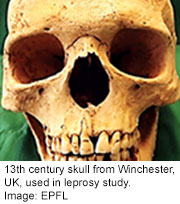
THURSDAY, June 13 (HealthDay News) — A close look at some very old bones is shedding light on the elimination of leprosy in Europe, where it was a major scourge until medieval times.
Leprosy was common across medieval Europe and nearly one in 30 people are thought to have had the disease. However, while it is still endemic in many parts of the world today — affecting over 200,000 people across the globe — leprosy all but disappeared in Europe by the turn of the 16th century.
The reasons for this sudden change have been a mystery.
In this new study, researchers decoded the nearly complete genomes of five strains of Mycobacterium leprae, the bacterium that causes leprosy. The samples were collected from the bones of people buried in medieval graves across Europe.
The study seems to rule out sudden genetic changes as the reason for leprosy disappearing from Europe. That’s because the genomes of the medieval strains are almost identical to those of modern strains of leprosy, and the mode of spreading the disease has not changed, researchers reported June 13 in the journal Science.
Therefore, “if the explanation of the drop in leprosy cases isn’t in the pathogen, then it must be in the host, that is, in us; so that’s where we need to look,” study co-director Stewart Cole, head of the Global Health Institute at the Swiss Federal Institute of Technology in Lausanne, said in an institute news release.
There are many clues that people in medieval Europe developed resistance to the disease, according to Cole. But “natural selection” may also have been key, involving the social isolation of people with the disease.
“In certain conditions, victims could simply be pressured not to procreate,” Cole reasoned. “In addition, other studies have identified genetic causes that made most Europeans more resistant than the rest of the world population, which also lends credence to this hypothesis.”
The research also turned up an interesting correlation between leprosy in the Middle East and Europe. According to the researchers, a strain of the disease found in medieval bones from Sweden and the United Kingdom is very similar to that found today in the Middle East. “The pathogen could have been carried to Palestine during the Crusades. But the process could have operated in the opposite direction, as well,” Cole said.
In addition to its historical significance, the study sheds new light on the workings of the leprosy pathogen and improve understanding of epidemics, according to the researchers.
More information
The U.S. National Institute of Allergy and Infectious Diseases has more about leprosy.

